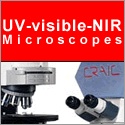Feb 9 2009
Trace amounts of organic and inorganic contaminants of hard disk components are extremely difficult to detect by current methods. Common techniques, such as inspection with optical microscopes will not show any of the contamination that is affect the products. CRAIC Technologies, Inc, a global leader in application-focused microanalysis solutions, has developed instruments and software that enable hard disk manufactures to rapidly detect contamination.

The QDI 2010™ microspectrophotometer, from CRAIC Technologies, is configured so that it can be used to both locate and identify the sources of contaminants. This is done by combining both ultraviolet microscopy spectral imaging with the analytical capabilities of UV-visible-NIR microspectroscopy. The CRAIC Technologies QDI 2010™ microspectrophotometer features these capabilities in a single, easy-to-use, cost effective instrument.
Many organic and inorganic contaminants found in hard disk drives absorb light in the ultraviolet region but are invisible to the naked eye. This means that standard optical microscopy will not be able to detect these contaminants nor is it capable of analyzing them. While other techniques are available, they require extensive sample preparation and can damage the sample.
By utilizing ultraviolet micro-imaging of the QDI 2010™, the user is able to quickly, easily and non-destructively locate many contaminants. UV microspectroscopy can then be performed with the QDI 2010™ to measure the electronic spectral characteristics of the contaminant in order to identify it. The spectra can also be used to further improve the clarity of the image of the contaminants by determining the wavelength of maximum absorbance.
By combining both techniques in the QDI 2010™ microspectrophotometer, the user is easily able to locate and identify contaminant materials in hard disk drive components such as read-write heads. The QDI 2010™ microspectrophotometer is the first system ever to combine both UV microscopy and microspectroscopy in a single tool. It can also be upgraded to enable ultraviolet, visible and near infrared reflectance, transmittance and fluorescence microscopy and microspectroscopy.